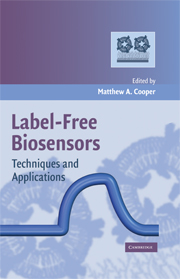Book contents
- Frontmatter
- Contents
- Contributors
- Preface
- LABEL-FREE BIOSENSORS
- 1 Label-free optical biosensors: An introduction
- 2 Experimental design
- 3 Extracting affinity constants from biosensor binding responses
- 4 Extracting kinetic rate constants from binding responses
- 5 Sensor surfaces and receptor deposition
- 6 Macromolecular interactions
- 7 Interactions with membranes and membrane receptors
- 8 Application of SPR technology to pharmaceutical relevant drug-receptor interactions
- 9 High-throughput analysis of biomolecular interactions and cellular responses with resonant waveguide grating biosensors
- 10 ITC-derived binding constants: Using microgram quantities of protein
- 11 Electrical impedance technology applied to cell-based assays
- Index
- Plate section
8 - Application of SPR technology to pharmaceutical relevant drug-receptor interactions
Published online by Cambridge University Press: 05 May 2010
- Frontmatter
- Contents
- Contributors
- Preface
- LABEL-FREE BIOSENSORS
- 1 Label-free optical biosensors: An introduction
- 2 Experimental design
- 3 Extracting affinity constants from biosensor binding responses
- 4 Extracting kinetic rate constants from binding responses
- 5 Sensor surfaces and receptor deposition
- 6 Macromolecular interactions
- 7 Interactions with membranes and membrane receptors
- 8 Application of SPR technology to pharmaceutical relevant drug-receptor interactions
- 9 High-throughput analysis of biomolecular interactions and cellular responses with resonant waveguide grating biosensors
- 10 ITC-derived binding constants: Using microgram quantities of protein
- 11 Electrical impedance technology applied to cell-based assays
- Index
- Plate section
Summary
INTRODUCTION
Selection of promising, well-characterized hits and leads is essential for success in the drug discovery process. To this end, new technologies that enable screening for new hits and profiling them with respect to their interaction with the targeted biological system are highly demanded in the pharmaceutical industry. The biological system can be a single biomolecule or a cascade of biomolecules including the target or a whole cellular system. Independent from the targeted biological system, detailed information on the interaction of potential drug candidates with the targeted biomolecule form the basis for understanding more complex schemes. Binding assays provide such information on affinity, kinetics, and thermodynamics.
Until recently, obtaining reliable data was often difficult and time-consuming because most of the methods available used labeled compounds that had to be specially synthesized. Biophysical binding assays generate label-free, high-quality data on the interaction between a target and a potential drug candidate. Label-free screening methods include isothermal titration calorimetry (ITC), analytical ultracentrifugation (AUC), nuclear magnetic resonance spectroscopy, mass spectroscopy, and biosensor.
Biosensors, as described in this book, are the tools most often used. They offer rapid access to these relevant binding data without the need for labeling interacting molecules. These biosensors measure in real time the quantity of the complex formed between a molecule immobilized on the sensor surface and a molecule in solution.
- Type
- Chapter
- Information
- Label-Free BiosensorsTechniques and Applications, pp. 179 - 205Publisher: Cambridge University PressPrint publication year: 2009



